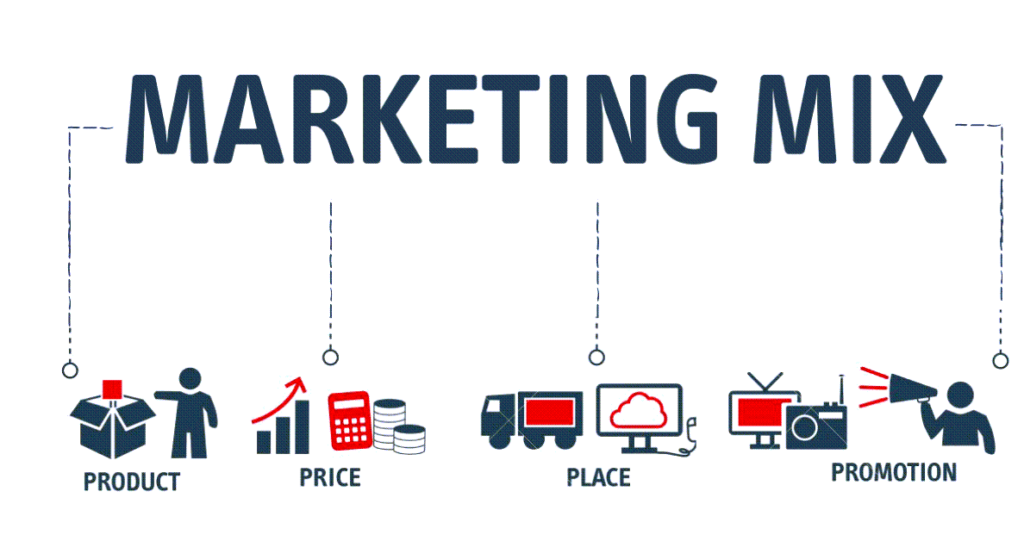Having a strong marketing strategy is crucial to developing a sustainable competitive advantage. It can serve as a compass, guiding your business towards a growing customer base. However, with a plethora of different marketing tactics available, it’s unrealistic to expect to be able to implement all of them without spreading yourself too thin. For a marketing strategy to be effective, it must focus only on the tactics that will reach your target market most efficiently.
In this article, we’ll explain the various marketing tactics so you can make an informed decision about what will work best for your business objectives. We’ll also outline how to best create a marketing strategy and measure its effectiveness.
If you’re taking the first steps to developing an online presence for your business, we also have a handy 7-step plan to creating a website.
Understanding Marketing Strategies
Before we dive into all the details, let’s start with the basics and define exactly what a marketing strategy is. A marketing strategy is a comprehensive, long-term plan outlining how you intend to promote your products or services to your target audience. It serves as a roadmap to guide all your marketing initiatives and marketing efforts.

Marketing Strategy vs. Marketing Plan
It’s a common misconception that the terms marketing strategy and marketing plan are the same thing and can be used interchangeably. However, they’re two distinct things:
Your company’s Marketing Strategy helps clarify what you need to do to achieve your marketing goals and maintain a competitive advantage. Your marketing strategy outlines the long-term framework that shapes:
- How you define your value proposition
- Your company’s brand positioning
- How you intend to reach your target market
Your Marketing Plan, on the other hand, focuses on the more day-to-day and short-term aspects of your marketing efforts, like specific campaigns. It’s essentially the execution of your overall marketing strategy.
Why Is A Marketing Strategy Important?
Even if your business is doing well now, thanks to word of mouth or foot traffic, having a robust marketing strategy in place is essential to keep that momentum going. It provides direction, ensures consistency, and helps you seize opportunities in the market.
It Helps You Spend Money In The Right Places
Having a clear marketing strategy also ensures you’re spending your money in the right places. Through conducting market research and identifying your target audience, you can guarantee your budget is allocated to the most effective marketing strategies for reaching prospective consumers.
What An Effective Marketing Strategy Outlines
Now that we’ve covered the basics of marketing strategies, we’ll go over the 11 steps to take if you want to create a marketing strategy for your business:
1. Define Your Business Goals
The purpose of a marketing strategy is to ultimately drive forward your business goals, so clearly defining what these goals are is what will shape your overall marketing efforts. Whether you aim to increase sales, improve brand recognition, expand into new markets, rebrand, or achieve other objectives, your marketing approach should align with these goals.
This alignment will serve as the foundation for your marketing strategy and the tactics you choose to take.

2. Conduct Market Research
The next step is to research your competitors and industry trends thoroughly. This will help you gauge your business’s standing in the market and understand which marketing strategies have worked well or not for other companies in your industry.
Know Where You Stand In The Market
By evaluating your competitors’ performance through competitive analysis, you can identify areas where your business can improve and leverage opportunities that your competitors might have missed. Furthermore, analysing industry trends will keep you informed on emerging technologies, evolving customer preferences, and new marketing channels, giving you a competitive advantage.
3. Identify Your Target Audience
Before implementing a marketing strategy of any kind, it’s important to have a clear understanding of who it is you’re trying to target. Your target audience represents the specific group of people who are most likely to be interested in your products or services.
By identifying your target audience and understanding their needs, preferences, and behaviours, you can tailor your marketing strategy accordingly for much more effective results.
Find your ideal customer base
When defining your ideal customer, consider demographics, psychographics, geographic location, and behaviour patterns. This data will help you create in-depth buyer personas, which are fictional representations of your ideal customers. These personas aid in visualising your audience, making it easier to produce content and messages that truly resonate with their needs and challenges.
4. Set Specific Marketing Objectives
Set clear and obtainable marketing goals. This is a pivotal step in planning your marketing strategy. Your marketing strategy becomes more focused and effective when your objectives are specific, measurable, achievable, relevant, and time-bound (SMART).
It’s essential that your marketing objectives align with your business goals, as we outlined in Step 1. Here are some examples:
Example 1: If your business goal is to increase brand awareness, your marketing goal might be to boost social media followers and engagement through an active social media presence and engaging content. Implement a social media campaign that encourages user-generated content.
Example 2: If your business goal is to increase revenue, your marketing goal might be to increase online sales through targeted digital marketing campaigns and search engine optimisation (SEO).
These examples show how clearly defining what you want to achieve can make your marketing strategy goals laser-focused. This, in turn, will make it easier to make decisions and will result in a more successful marketing strategy overall.

5. Choose Your Marketing Channels
Now it’s time to decide where you’ll focus your marketing initiatives, using the knowledge you gained of your target audience, competitors and industry trends. Choosing your marketing channels isn’t a decision to take lightly – the channels you choose have a direct impact on how effectively you reach and engage your target audience and shape your marketing strategy as a whole.
What Is A Marketing Channel?
Marketing channels are the methods or platforms you choose to communicate with your audience through. This can be through digital assets or more traditional marketing. Digital marketing channels include:
- Email marketing
- Social media campaigns
- Search engine marketing
- Paid ads or pay-per-click advertising on social media channels
- Content marketing
This is not by any means a comprehensive list of digital marketing strategies. If you’re looking for more ideas and in-depth explanations, check out our article on the types of digital marketing Canberra businesses should use.
Traditional marketing channels, on the other hand, include:
- Print media
- TV or radio advertising
- Trade shows and events
- Direct sales
Reach Your Prospective Consumers Where They Are
Each channel has its strengths and weaknesses. The most important consideration is which one will have the most customer engagement. You have to go where your potential customers are to reach them effectively.
Using buyer personas and target market research, ask yourself if your target customers are more engaged on social media, if they frequently read email newsletters, if they prefer in-person events, and so on. The channels you choose should align with the preferences and behaviours of your target markets and potential customers.
6. Develop a Unique Value Proposition
Your unique value proposition is the distinct element that sets your product apart from your competitors and answers the fundamental question, ‘Why should new customers choose you?’
Look at any competitive advantages you might have and the key benefits you provide. Is your product of a higher quality than your competition? Is it more affordable? Do you have an extra focus on eco-friendly practices or excellent customer experience? How are you hoping to develop customer loyalty?
Your marketing teams should be able to boil down your unique value proposition into one concise, compelling statement that can serve as the core focus for all your marketing activities. Ultimately, your unique value proposition is the cornerstone of your brand identity and any successful marketing strategy.

7. Set Your Budget Allocation For Your Marketing Strategy
A firm, well-thought-out budget is vital to a clearly defined strategy. Your budget determines the available resources available for each marketing campaign, and how you distribute those resources can significantly impact your marketing performance.
Once you’ve set a total budget for what your company aims to spend on marketing, you have to decide what your marketing strategy covers and what you will prioritise most. The marketing tactics that will deliver the highest return on investment and align with your target audience’s preferences should be at the top of the list!
Time is Money
When defining your marketing budget, it’s also important to factor in time spent. While some marketing tactics are more cost-effective than others, they might require more dedication and working hours from your marketing or sales team.
Content marketing is a good example – although this marketing activity comes with no upfront costs, it requires a lot of time and effort from your team to be effective. However, the chance to increase organic traffic is often worth it! Here’s an explanation of why organic traffic is so high-value.
Keep Your Business Objectives In Mind
Your budget allocation should align with your overall goals. Are you trying to increase your number of website visitors and grow your digital presence? Allocate more of your marketing budget towards search engine marketing. Are you trying to retain more existing customers? Focus your marketing budget on developing customer loyalty programs.
8. Create A Marketing Mix
Your marketing mix outlines all of the decisions you’ve made during the previous steps in one place through a combination of four elements: Product, Price, Place, and Promotion, or the 4 Ps. The 4 Ps are an essential part of any go-to-market plan, but clearly outlining them in a marketing strategy document can help provide focus and direction to your marketing activity even if your business is long established.

The 4 Ps Of A Marketing Mix
1. Product
Product refers to the unique features of your product compared to your competitors. From an internal perspective, it also refers to how your product will continue to evolve over time to meet customer needs and how you plan on positioning your product to carve out a market share (affordable, luxury, niche, etc).
2. Price
Price refers to your pricing strategy, taking into account things like production costs, your competitor’s pricing and how much your target audience is willing to pay for your product. It also refers to how much you can afford to mark down your product during sales and promotional periods.
3. Place
Place is where and how your product will be available: through online sales, physical stores, third-party retailers, or a combination of the three. Is your product available locally, regionally, nationally or globally?
4. Promotion
Promotion is how you plan on reaching prospective consumers and which elements of a marketing strategy will be most effective. It also includes your messaging, visual style, and the marketing platforms you’ve chosen.
The 4 Ps Are Your Guidelines
Clearly outlining these four elements in one document will serve as a handy anchor to your business’s essential values and goals when developing your marketing strategy. It will also be useful if you plan on out-sourcing any of your marketing efforts, as the 4 Ps can succinctly convey the direction you want to take and how you’ll get there to any external parties.
9. Create A Detailed Marketing Plan
Now that you have a clearly defined marketing strategy, it’s time to create a comprehensive marketing plan that outlines how you are going to implement it. As we explained above, your marketing strategy helps provide the foundation for your marketing plan and guides all of your decisions. It helps you define the “why” of your marketing efforts, while your marketing plan focuses on the “how.”
Your marketing plan should include specific tactics, content, and activities that you will use to achieve your objectives. It should also have a clear timeline with deadlines and a schedule to help you stay on track. If you need a little guidance, you can find a free marketing plan template online.

10. Establish Key Performance Indicators (KPIs)
Key Performance Indicators (KPIs) are quantifiable metrics that will help you determine the success of your marketing plan after you’ve implemented it. They provide valuable insights into whether your marketing efforts are working to achieve your goals or if you need to re-calibrate.
Your KPIs should be clear and directly tied to your marketing objectives. For example, if one of your marketing goals is to increase website traffic, a KPI might be to “increase monthly website visitors by 20% within six months.”
Number-centric targets
For your KPIs to be as accurate as possible, they have to be measurable metrics that can’t be swayed by subjectivity. They should involve marketing analytics with numbers, percentages, or specific values that can be tracked. This can include conversion rates, website sessions, revenue generated, social media engagement metrics, or email open rates.
11. Adapt & Evolve Your Marketing Strategy
Now that you’ve put your marketing strategy and plans in place, it’s important to assess, adjust and evolve it over time to suit changing markets and customer needs. This will help your company’s marketing strategy stay competitive over time and keep customer engagement high.
To keep your marketing strategy dynamic and optimised, you should conduct ongoing market analysis and KPI tracking, listen to customer experience feedback and do a semi-regular marketing strategy review.
Stay Innovative
Technology and how people respond to them is constantly changing. Even if your target audience responds best to print or email marketing now, this might change over time. This is why you should embrace innovation with your marketing strategy – experimenting with new technologies, platforms, and marketing methods can help you stay ahead of the curve.
Need Help Developing and Implementing A Marketing Strategy?
At Futuretheory, we’re experts in strategic marketing based on data-driven insights and backed by results. Creating a marketing strategy is complicated, and implementing it successfully even more so. Our experienced team can take the hassle out of marketing, whether it’s through consulting and training, branding, SEO, copywriting, or advertising.
We also offer a comprehensive range of website services, including web design, development, hosting, and maintenance. If you need help growing your business online, building your identity or reaching more people, contact us today.



